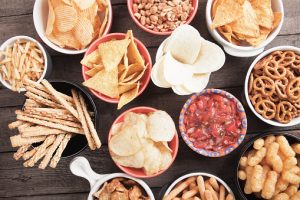 Maintaining a healthy diet can be difficult, especially when trying to avoid consuming excessive quantities of salt, which are a major contributor to high blood pressure (hypertension). According to a recent U.S. government report, there are many sources of salt that might surprise you.
Maintaining a healthy diet can be difficult, especially when trying to avoid consuming excessive quantities of salt, which are a major contributor to high blood pressure (hypertension). According to a recent U.S. government report, there are many sources of salt that might surprise you.
You may already be aware that foods such as potato chips and pretzels contain high amounts of salt, but they are not the most common sources that Americans consume every day. The top five culprits are:
- Bread
- Pizza
- Sandwiches
- Cold cuts and cured meats
- Soup
Advertisement
“Most Americans are consuming too much salt and it’s coming from a lot of commonly consumed foods—about 25 foods contribute the majority of salt,” said lead researcher Zerleen Quader. She’s an analyst from the U.S. Centers for Disease Control and Prevention. “Knowing which foods contribute the most salt is important for reducing your salt intake,” she said.
While sodium is an essential component of our daily intake of nutrition, too much sodium increases the risk of high blood pressure, which is a major risk factor for heart attack and stroke. Sodium is required by the body to help maintain fluid balance, according to the American Heart Association, but most Americans are simply consuming too much. Table salt is 40 percent sodium, with one tablespoon containing as much as 2,300mg of sodium—the maximum daily amount recommended by heath experts. The American Heart Association’s ideal recommended intake is 1,500mg daily.
Most of the salt consumed by Americans don’t come from their salt shaker but are hidden in pre-made, pre-packaged foods that are aimed at convenience and flavor rather than health. A new Center for Disease Control (CDC) report found that in 2013–2014, Americans consumed about 3,400mg of salt daily, far exceeding daily recommendations.
It may not just be that Americans are eating food with increased levels of salt, but are eating increased quantities of foods with moderate salt levels in them, increasing their daily recommended intake of the mineral. One way to reduce salt consumption is to pay attention to food labels when shopping and choose the lowest salt option, Quader suggested.
“When cooking at home, use fresh herbs and other substitutes for salt. When eating out, you can ask for meals with lower salt,” she added.
CDC researchers found that 44 percent of the salt people eat comes from just 10 foods. These includes bread made with yeast, pizza, sandwiches, cold cuts and cured meats, soup, burritos and tacos, salted snacks, chicken, cheese, eggs, and omelets. Seventy percent of salt in the diet comes from 25 foods, some of which include bacon, salad dressing, French fries, and cereal, researchers found.
“Parents need to understand that feeding hot dogs, fries, and ham and cheese sandwiches to their kids (and themselves) are significantly increasing their risk for certain cancers, hypertension, and heart disease,” said Samantha Heller, a senior clinical nutritionist at New York University Medical Center in New York City.
Advertisement
Lowering salt in your diet is “as simple and as difficult as cooking at home and using fresh ingredients, as often as possible,” she suggested.
“This can save money and time in the long run and is certainly is better for our health,” Heller said. “It may take some time to re-pattern your shopping and eating habits, but your health is worth it.”
Related: 5 signs you’re consuming too much salt
